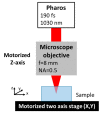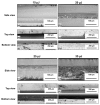One-Step Femtosecond Laser Stealth Dicing of Quartz
- PMID: 32235686
- PMCID: PMC7143800
- DOI: 10.3390/mi11030327
One-Step Femtosecond Laser Stealth Dicing of Quartz
Abstract
We report on a one-step method for cutting 250-µm-thick quartz plates using highly focused ultrashort laser pulses with a duration of 200 fs and a wavelength of 1030 nm. We show that the repetition rate, the scan speed, the pulse overlap and the pulse energy directly influence the cutting process and quality. Therefore, a suitable choice of these parameters was necessary to get single-pass stealth dicing with neat and flat cut edges. The mechanism behind the stealth dicing process was ascribed to tensile stresses generated by the relaxation of the compressive stresses originated in the laser beam focal volume during irradiation in the bulk material. Such stresses produced micro-fractures whose controlled propagation along the laser beam path led to cutting of the samples.
Keywords: heat accumulation; quartz; stealth dicing; transparent materials; ultrashort laser pulses.
Conflict of interest statement
The authors declare no conflict of interest.
Figures






References
-
- Yadav A., Kbashi H., Kolpakov S., Gordon N., Zhou K., Rafailov E.U. Stealth dicing of sapphire wafers with near infra-red femtosecond pulses. Appl. Phys. A Mater. Sci. Process. 2017;123:369. doi: 10.1007/s00339-017-0927-0. - DOI
-
- Trotta G., Volpe A., Ancona A., Fassi I. Flexible micro manufacturing platform for the fabrication of PMMA microfluidic devices. J. Manuf. Process. 2018;35:107–117. doi: 10.1016/j.jmapro.2018.07.030. - DOI
-
- Matsumaru K., Takata A., Ishizaki K. Advanced thin dicing blade for sapphire substrate. Sci. Technol. Adv. Mater. 2005;6:120–122. doi: 10.1016/j.stam.2004.11.002. - DOI
-
- Nisar S., Li L., Sheikh M.A. Laser glass cutting techniques—A review. J. Laser Appl. 2013;25:042010. doi: 10.2351/1.4807895. - DOI
LinkOut - more resources
Full Text Sources
Other Literature Sources

